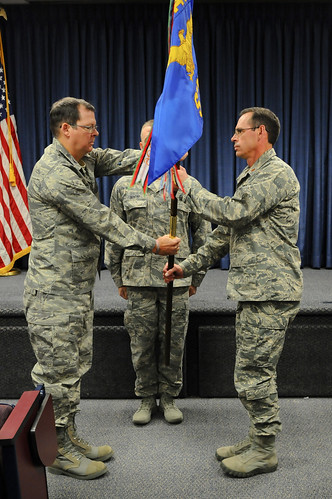Story by Staff Sgt. Vicky Spesard, 123rd Airlift Wing Public Affairs
[caption id="" align="alignright" width="266"]

Col. Robert Hamm (left), commander of the 123rd Operations Group, presents the guidon of the 123rd Special Tactics Squadron to Maj. Sean McLane, the unit's new commander, during a change-of-command ceremony held at the Kentucky Air National Guard Base in Louisville, Ky., Nov. 24, 2013. The passing of the guidon is a time-honored tradition signifying change of leadership. (U.S. Air National Guard photo by Staff Sgt. Vicky Spesard)
KENTUCKY AIR NATIONAL GUARD BASE, LOUISVILLE, Ky. — Maj. Sean McLane assumed command of the Kentucky Air National Guard’s 123rd Special Tactics Squadron during a change-of-command ceremony here Nov. 24.
He replaces Lt. Col. Jeffrey Wilkinson, who now serves as deputy air commander of the squadron’s parent organization, the 123rd Airlift Wing.
McLane began his Air Force career in 1993 as an enlisted tactical air controller before being commissioned as a distinguished graduate of the Air National Guard Academy of Military Science in 2002. He most recently served as director of operations for the 123rd Special Tactics Squadron and brings many years of experience to his new role.
“Having been the lowest enlisted member of the squadron, you get to see how all of the leadership’s decisions affect you,” McLane said during the ceremony. “I don’t want to be disconnected from that Airman. When that extra workload or difficulty comes to him, I want to know how he is affected.
“If I can’t change the outcome of how it affects him, I can explain to him why it has to be that way,” he continued. “What I really want is for people to understand why they are doing what they are doing and how it affects the mission.”
McLane first came to the Kentucky Air National Guard in 1996 when the special tactics unit was a flight of about 24 members. He earned his combat control beret in 1997, maintaining full combat mission-ready status as a traditional Guardsman while attending college and, eventually, teaching high school math, science and history. His military career includes assignments as a special tactics squadron flight commander and weapons and tactics officer.
“I have known Major McLane since he was an NCO, and I had a lot of respect for him then,” said Chief Master Sgt. Tom DeSchane, the squadron’s combat control enlisted manager. “He has vision and he likes to have as much input as he can before he makes decisions. I think that’s what is going to make him a successful commander for the STS.”
Now staffed with more than 80 personnel, the squadron provides a rapidly deployable force to establish positive control of the air-ground interface, battlefield trauma care, terminal attack control, personnel recovery and air/ground meteorological effects forecasting in support of overseas contingency operations and domestic disasters.
“I want people to be proud of the job that they are doing, proud of their squadron and proud to be a member of it,” McLane emphasized. “If they have the proud ownership of their position, they are going to do their job better.”
Mission readiness is another top priority. McLane has deployed numerous times in support of military contingency and combat operations, including Enduring Freedom and Iraqi Freedom; multiple Joint Chiefs of Staff-directed exercises; and civil natural-disaster response operations and state exercises.
“I’m not interested in fighting the last war,” he told the audience. “I’m interested in fighting the next one. I’m not interested in preparing for the last natural disaster we have faced. I am very concerned with being ready to respond to all of them."
“When you look at the mission of special tactics, our federal and state mission, where they overlap is what we are going to train to and what we are going to be good at. If we do that, we will be ready for the future war and be ready for what the state needs us to do.”